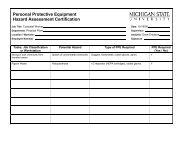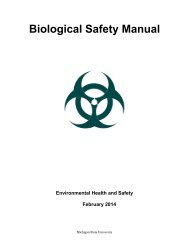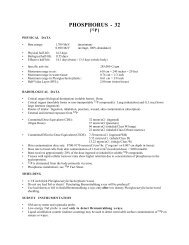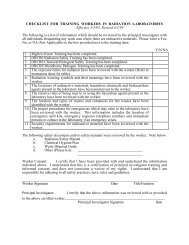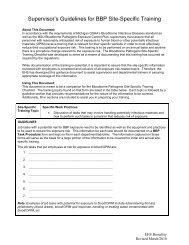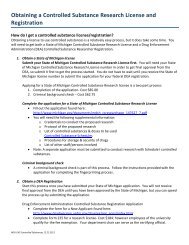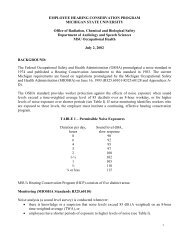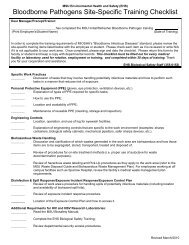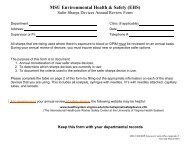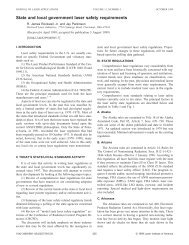Radiation Safety Manual Appendix: Iodination Safety Tips - the orcbs
Radiation Safety Manual Appendix: Iodination Safety Tips - the orcbs
Radiation Safety Manual Appendix: Iodination Safety Tips - the orcbs
Create successful ePaper yourself
Turn your PDF publications into a flip-book with our unique Google optimized e-Paper software.
IODINATION SAFETY TIPS<br />
Revised June, 1995<br />
<strong>Iodination</strong>s are performed commonly at MSU; however, with safe practices exposures do<br />
not occur. Air monitoring may be done during iodinations by ORCBS to assure that room air is<br />
not contaminated. Additionally, bioassays detect any uptakes which may occur. These bioassays<br />
are required for all workers performing iodinations.<br />
<strong>Iodination</strong> labeling, however, can create potential exposures to <strong>the</strong> thyroid in workers<br />
performing iodinations if proper safety precautions are not followed explicitly. 125 I in <strong>the</strong> Na 125 I<br />
chemical form is volatile, and exposure through inhalation routes can occur. Most iodinations are<br />
done with quantities of 1.0 mCi or greater, so very little airborne release of this concentrated<br />
material may cause a significant 125 I uptake.<br />
The following list of safety precautions will assist workers in preventing unnecessary<br />
exposures to 125 I during iodinations. If you have questions, or would like assistance in iodination<br />
procedures, please call 5-0153.<br />
1. All iodinations and use of Na 125 I must be conducted in a fume hood certified for<br />
radioisotope use. Work should be done at least 6 inches back from <strong>the</strong> front of <strong>the</strong> fume<br />
hood. Fume hoods should be free of clutter, and large objects should be placed on blocks<br />
to elevate <strong>the</strong>m 2 inches from <strong>the</strong> floor of <strong>the</strong> fume hood. The sash of <strong>the</strong> fume hood<br />
should be brought down to <strong>the</strong> lowest possible height while still maintaining ample room<br />
for manual dexterity.<br />
2. The fume hood should be covered with poly-backed absorbent paper to absorb possible<br />
spills, drips or airborne activity.<br />
3. Double gloves should be worn. Latex or N-Dex gloves are preferable because <strong>the</strong>y have a<br />
tighter fit, allowing good dexterity while wearing two or three pairs.<br />
4. Poly-backed absorbent paper should be taped to <strong>the</strong> floor in front of <strong>the</strong> fume hood to<br />
prevent contamination and spreading in <strong>the</strong> event of an accidental spill or release.<br />
5. Lab coats and film badges must be worn.<br />
6. A GM rate meter with a low energy gamma probe must be used during <strong>the</strong> iodination. It<br />
should be placed near <strong>the</strong> iodination hood (not inside <strong>the</strong> hood) with <strong>the</strong> audio on. A<br />
noticeable and substantial change in <strong>the</strong> audible count rate during <strong>the</strong> iodination is an<br />
indicator that will alert <strong>the</strong> worker to possible release from <strong>the</strong> fume hood. Procedures<br />
should <strong>the</strong>n be implemented to prevent fur<strong>the</strong>r release into <strong>the</strong> breathing air in <strong>the</strong> room.<br />
Call <strong>the</strong> ORCBS for advice on handling <strong>the</strong> situation.<br />
7. To remove <strong>the</strong> Na 125 I from <strong>the</strong> shipping vial, use an adapter to provide a conduit for <strong>the</strong><br />
syringe used to withdraw <strong>the</strong> aliquot. A short 16 gauge cannula needle, available from<br />
General Stores, makes an excellent adapter. This prevents <strong>the</strong> syringe needles from<br />
bending, possible skin punctures and vents <strong>the</strong> fumes before withdrawing <strong>the</strong> solution.<br />
8. Mix <strong>the</strong> reaction vial with a gentle tapping motion ra<strong>the</strong>r than shaking. Fumes are released<br />
in higher quantities with vigorous mixing; gently tap <strong>the</strong> reaction tube to provide gentle<br />
mixing. Hold <strong>the</strong> vial well up inside <strong>the</strong> hood so that fumes are drawn up through <strong>the</strong><br />
hood, ra<strong>the</strong>r than into <strong>the</strong> room air.<br />
9. NEVER collect iodination fractions outside <strong>the</strong> fume hood. High amounts of free iodine<br />
are contained in <strong>the</strong>se fractions, and intakes can occur if <strong>the</strong> tubes are not collected in <strong>the</strong><br />
hood.<br />
10. NEVER count fractions from iodinations in tubes or vials which are not tightly capped.<br />
Dispose of counting tubes or vials with caps on in <strong>the</strong> iodination waste, not in <strong>the</strong> regular<br />
125 I waste.<br />
11. Contain all waste from <strong>the</strong> iodination as it is generated. Tape double plastic bags to <strong>the</strong><br />
wall of <strong>the</strong> fume hood in an accessible location. Place dry waste in <strong>the</strong>se bags. Liquid<br />
waste should be deposited in plastic bottles with screw-top caps to contain release. When
<strong>the</strong> iodination is finished, place both dry and liquid waste in double ziplok plastic bags, and<br />
label <strong>the</strong> waste with radioactive waste tags. Denote "Free 125 I" on <strong>the</strong> waste tag.<br />
12. Store all syringes, glassware and o<strong>the</strong>r equipment that is reused in <strong>the</strong> iodination fume<br />
hood between uses. Label all iodination equipment thoroughly.<br />
13. Thyroid scans must be performed on workers after each iodination. A baseline thyroid<br />
scan is done to determine a background for each iodinater prior to conducting iodinations at<br />
MSU. Post-iodination thyroid scans are done no less than 24 hours after <strong>the</strong> iodination,<br />
and no longer than 1 week after <strong>the</strong> iodination. Thyroid scans are required by law, and not<br />
obtaining <strong>the</strong>m may cause a violation of our NRC license conditions. Call <strong>the</strong> ORCBS to<br />
obtain a thyroid scan.<br />
14. If a spill occurs inside <strong>the</strong> fume hood during an iodination, close <strong>the</strong> hood sash completely.<br />
If a spill occurs outside <strong>the</strong> fume hood, place absorbent on <strong>the</strong> spill and evacuate personnel<br />
from <strong>the</strong> room. Call <strong>the</strong> ORCBS immediately to notify that <strong>the</strong> spill has occurred.<br />
15. After every iodination, thoroughly survey <strong>the</strong> entire area, including floors, hood,<br />
equipment, outer waste container surfaces, hands, feet and clothing.<br />
EMERGENCY PROCEDURES FOR FREE 125 I ACCIDENT<br />
In <strong>the</strong> event of an accident with free iodine outside <strong>the</strong> hood, don't panic. Immediately get<br />
everyone out of <strong>the</strong> room. If possible, grab <strong>the</strong> rate meter on your way out. To minimize <strong>the</strong><br />
spread of contamination, <strong>the</strong> people involved should go to a single, pre designated location and<br />
close <strong>the</strong> door. (A desirable location would have available a telephone, sink, hood and be in a<br />
"low traffic" area. The hallway outside <strong>the</strong> room may be <strong>the</strong> only choice if <strong>the</strong>re are no adjacent<br />
rooms with closing doors.)<br />
It is recommended that some disposable lab matting or o<strong>the</strong>r absorbent paper be placed on <strong>the</strong> floor<br />
for people to stand on, until <strong>the</strong>y can be surveyed and found free of contamination or<br />
decontaminated. If you have any contamination on your skin, wash it off. If your clothing is<br />
contaminated, remove <strong>the</strong> affected articles and place in <strong>the</strong> hood. Be sure <strong>the</strong> hood is turned on.<br />
During regular work days and hours call <strong>the</strong> ORCBS at 5-0153 and request to speak to a health<br />
physics staff member. Tell <strong>the</strong> person answering <strong>the</strong> phone that you are reporting a radiation<br />
emergency. Then call your PI and let him/her know exactly what has happened and what you have<br />
done thus far.<br />
If an accident occurs after regular working hours, dial 911, tell <strong>the</strong> dispatcher that you have a<br />
radiation emergency and need <strong>Radiation</strong> <strong>Safety</strong> assistance. (They will call <strong>the</strong> ORCBS emergency<br />
pager.) Be prepared to provide <strong>the</strong> following information:<br />
1. Medical services required, if any (paramedics, ambulance)<br />
2. Your name<br />
3. Building name and room number<br />
4. Your phone number - where you can be reached<br />
5. Name of lab's principal investigator<br />
6. Isotope involved<br />
7. Chemical form of isotope or say it is an iodination accident<br />
8. Estimation of amount of activity involved<br />
9. Number of people involved<br />
10. What has been done thus far<br />
Then call your PI, if possible, and give <strong>the</strong> same information.



